Financial Planning, Budgeting, and Reporting in Hospitality
VerifiedAdded on 2022/11/14
|13
|3076
|128
Report
AI Summary
This report delves into the crucial aspects of financial management within the hospitality sector. It begins by outlining methods for planning, including analyzing profit and loss statements, investigating the causes of profit or loss, forecasting expenses, and assessing cash flow trends using financial ratios like accounts receivable turnover, accounts payable turnover, and inventory turnover. The report also covers taxation requirements and the selection of appropriate financial management software. Furthermore, it details the steps involved in creating a budget, from identifying business goals to defining income sources and costs. The report then discusses budget implementation, evaluation, and the preparation of financial reports such as cost reports and cash flow reports, highlighting their importance and the intended audience. Overall, the report provides a comprehensive overview of financial management practices tailored for the hospitality industry, aiming to assist businesses in planning, controlling, and making informed financial decisions.
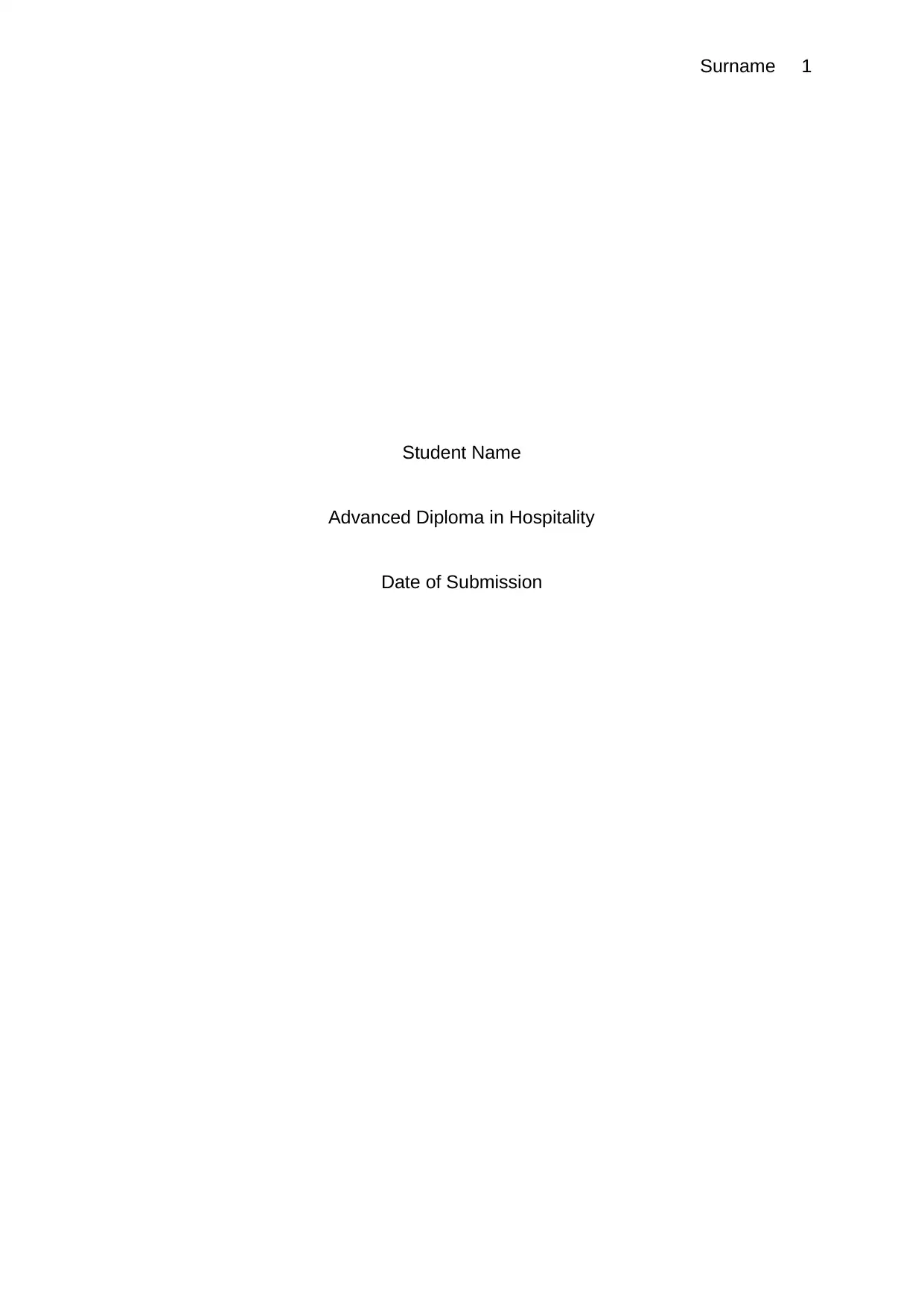
Surname 1
Student Name
Advanced Diploma in Hospitality
Date of Submission
Student Name
Advanced Diploma in Hospitality
Date of Submission
Paraphrase This Document
Need a fresh take? Get an instant paraphrase of this document with our AI Paraphraser
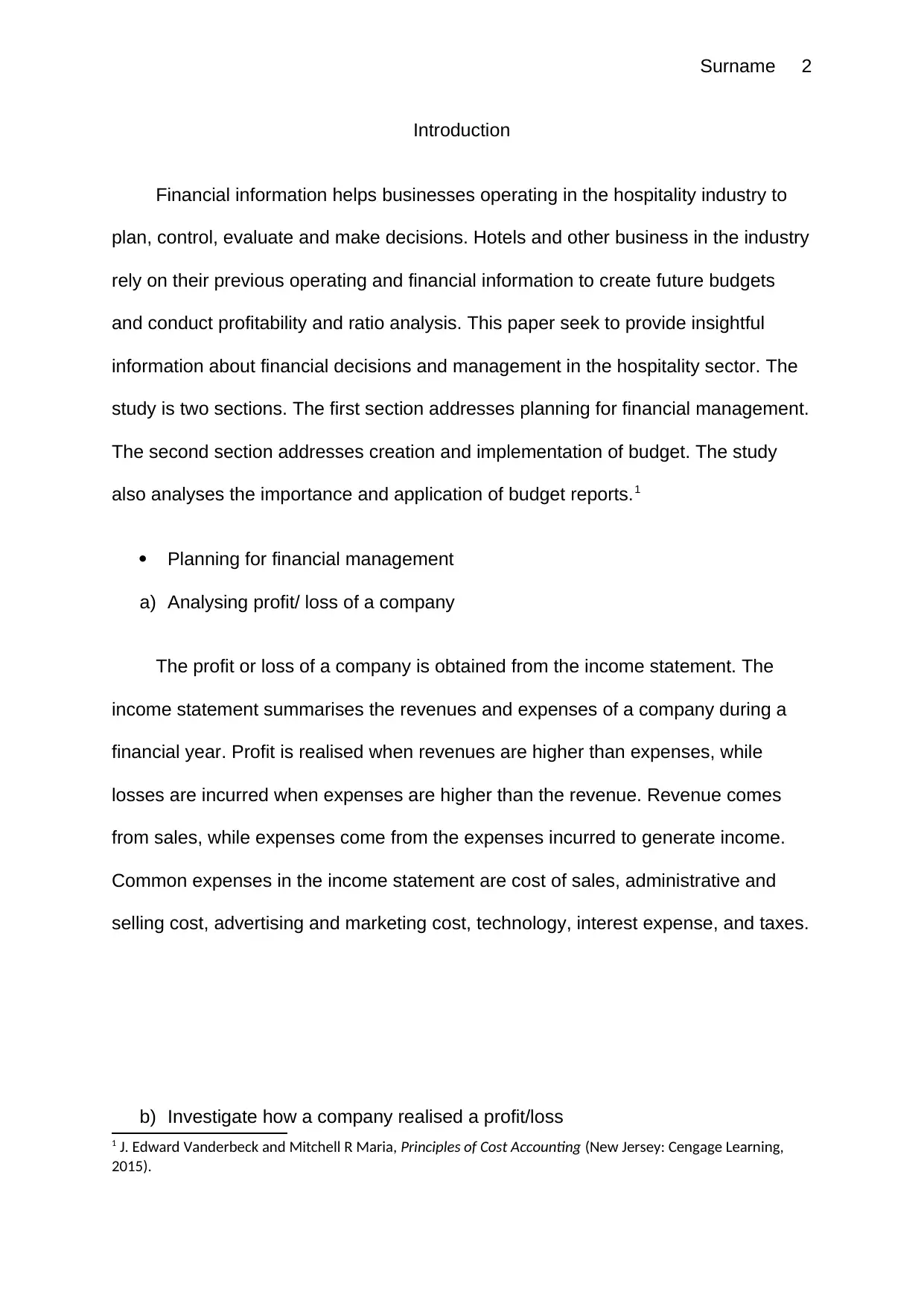
Surname 2
Introduction
Financial information helps businesses operating in the hospitality industry to
plan, control, evaluate and make decisions. Hotels and other business in the industry
rely on their previous operating and financial information to create future budgets
and conduct profitability and ratio analysis. This paper seek to provide insightful
information about financial decisions and management in the hospitality sector. The
study is two sections. The first section addresses planning for financial management.
The second section addresses creation and implementation of budget. The study
also analyses the importance and application of budget reports.1
Planning for financial management
a) Analysing profit/ loss of a company
The profit or loss of a company is obtained from the income statement. The
income statement summarises the revenues and expenses of a company during a
financial year. Profit is realised when revenues are higher than expenses, while
losses are incurred when expenses are higher than the revenue. Revenue comes
from sales, while expenses come from the expenses incurred to generate income.
Common expenses in the income statement are cost of sales, administrative and
selling cost, advertising and marketing cost, technology, interest expense, and taxes.
b) Investigate how a company realised a profit/loss
1 J. Edward Vanderbeck and Mitchell R Maria, Principles of Cost Accounting (New Jersey: Cengage Learning,
2015).
Introduction
Financial information helps businesses operating in the hospitality industry to
plan, control, evaluate and make decisions. Hotels and other business in the industry
rely on their previous operating and financial information to create future budgets
and conduct profitability and ratio analysis. This paper seek to provide insightful
information about financial decisions and management in the hospitality sector. The
study is two sections. The first section addresses planning for financial management.
The second section addresses creation and implementation of budget. The study
also analyses the importance and application of budget reports.1
Planning for financial management
a) Analysing profit/ loss of a company
The profit or loss of a company is obtained from the income statement. The
income statement summarises the revenues and expenses of a company during a
financial year. Profit is realised when revenues are higher than expenses, while
losses are incurred when expenses are higher than the revenue. Revenue comes
from sales, while expenses come from the expenses incurred to generate income.
Common expenses in the income statement are cost of sales, administrative and
selling cost, advertising and marketing cost, technology, interest expense, and taxes.
b) Investigate how a company realised a profit/loss
1 J. Edward Vanderbeck and Mitchell R Maria, Principles of Cost Accounting (New Jersey: Cengage Learning,
2015).
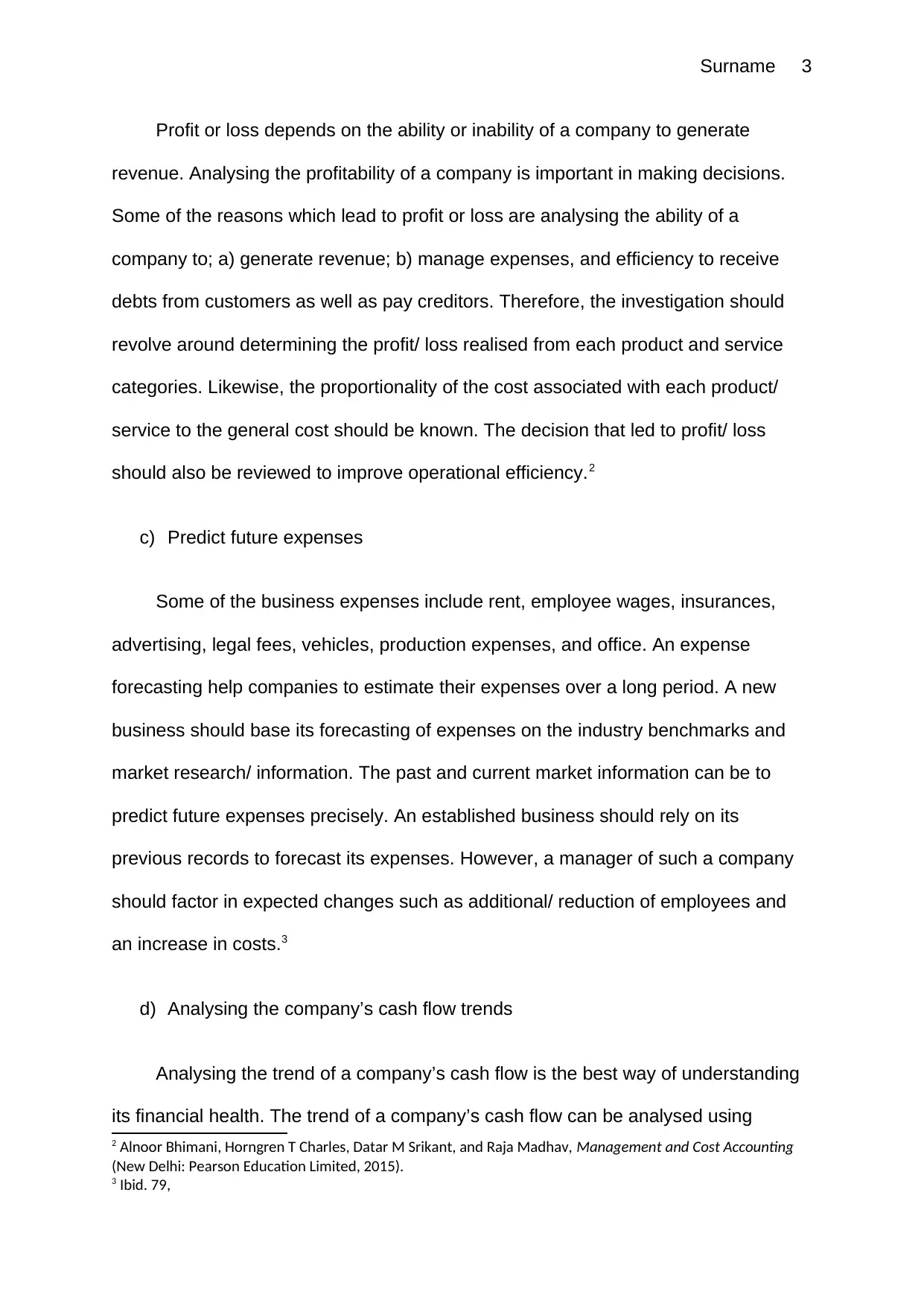
Surname 3
Profit or loss depends on the ability or inability of a company to generate
revenue. Analysing the profitability of a company is important in making decisions.
Some of the reasons which lead to profit or loss are analysing the ability of a
company to; a) generate revenue; b) manage expenses, and efficiency to receive
debts from customers as well as pay creditors. Therefore, the investigation should
revolve around determining the profit/ loss realised from each product and service
categories. Likewise, the proportionality of the cost associated with each product/
service to the general cost should be known. The decision that led to profit/ loss
should also be reviewed to improve operational efficiency.2
c) Predict future expenses
Some of the business expenses include rent, employee wages, insurances,
advertising, legal fees, vehicles, production expenses, and office. An expense
forecasting help companies to estimate their expenses over a long period. A new
business should base its forecasting of expenses on the industry benchmarks and
market research/ information. The past and current market information can be to
predict future expenses precisely. An established business should rely on its
previous records to forecast its expenses. However, a manager of such a company
should factor in expected changes such as additional/ reduction of employees and
an increase in costs.3
d) Analysing the company’s cash flow trends
Analysing the trend of a company’s cash flow is the best way of understanding
its financial health. The trend of a company’s cash flow can be analysed using
2 Alnoor Bhimani, Horngren T Charles, Datar M Srikant, and Raja Madhav, Management and Cost Accounting
(New Delhi: Pearson Education Limited, 2015).
3 Ibid. 79,
Profit or loss depends on the ability or inability of a company to generate
revenue. Analysing the profitability of a company is important in making decisions.
Some of the reasons which lead to profit or loss are analysing the ability of a
company to; a) generate revenue; b) manage expenses, and efficiency to receive
debts from customers as well as pay creditors. Therefore, the investigation should
revolve around determining the profit/ loss realised from each product and service
categories. Likewise, the proportionality of the cost associated with each product/
service to the general cost should be known. The decision that led to profit/ loss
should also be reviewed to improve operational efficiency.2
c) Predict future expenses
Some of the business expenses include rent, employee wages, insurances,
advertising, legal fees, vehicles, production expenses, and office. An expense
forecasting help companies to estimate their expenses over a long period. A new
business should base its forecasting of expenses on the industry benchmarks and
market research/ information. The past and current market information can be to
predict future expenses precisely. An established business should rely on its
previous records to forecast its expenses. However, a manager of such a company
should factor in expected changes such as additional/ reduction of employees and
an increase in costs.3
d) Analysing the company’s cash flow trends
Analysing the trend of a company’s cash flow is the best way of understanding
its financial health. The trend of a company’s cash flow can be analysed using
2 Alnoor Bhimani, Horngren T Charles, Datar M Srikant, and Raja Madhav, Management and Cost Accounting
(New Delhi: Pearson Education Limited, 2015).
3 Ibid. 79,
⊘ This is a preview!⊘
Do you want full access?
Subscribe today to unlock all pages.

Trusted by 1+ million students worldwide
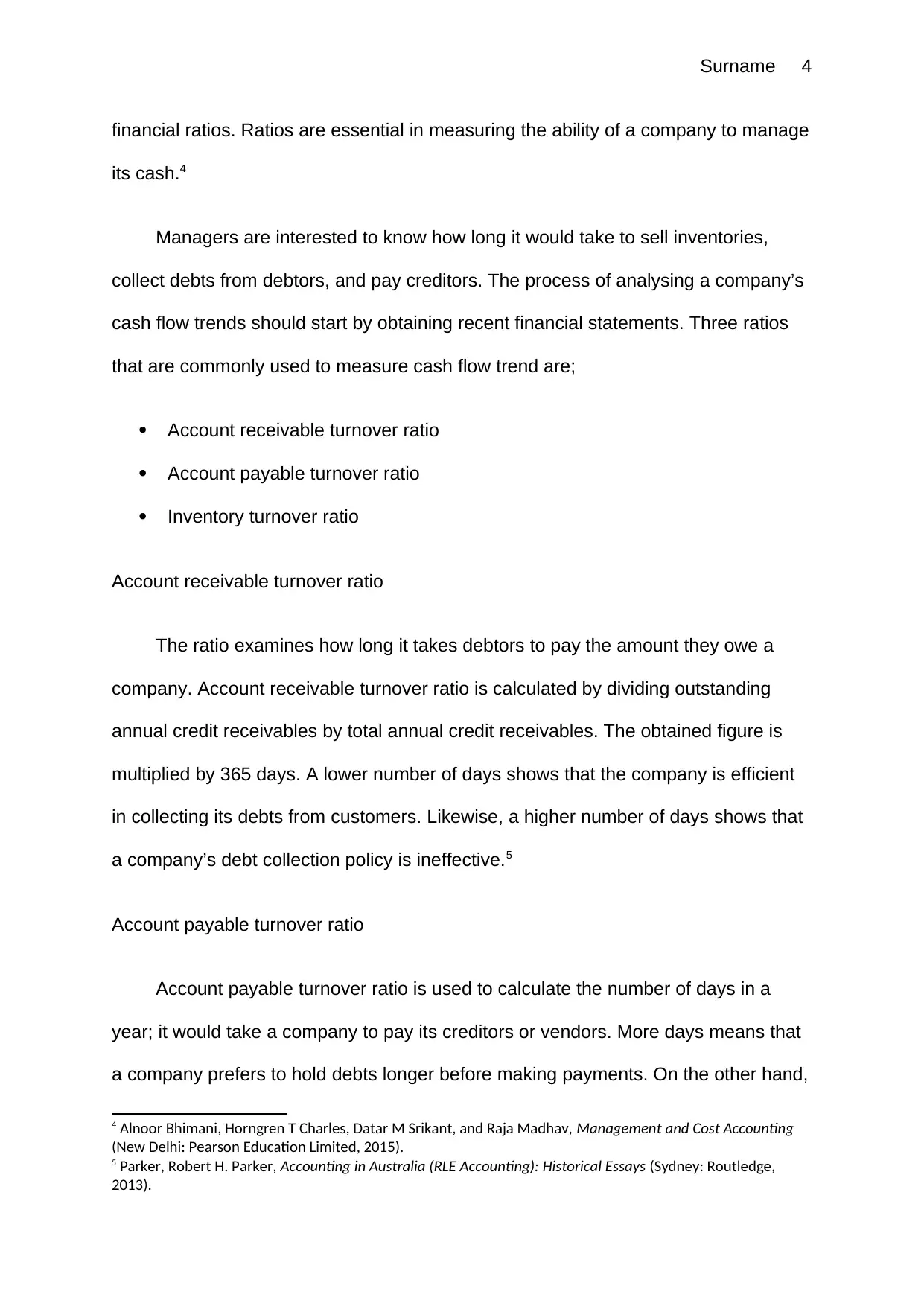
Surname 4
financial ratios. Ratios are essential in measuring the ability of a company to manage
its cash.4
Managers are interested to know how long it would take to sell inventories,
collect debts from debtors, and pay creditors. The process of analysing a company’s
cash flow trends should start by obtaining recent financial statements. Three ratios
that are commonly used to measure cash flow trend are;
Account receivable turnover ratio
Account payable turnover ratio
Inventory turnover ratio
Account receivable turnover ratio
The ratio examines how long it takes debtors to pay the amount they owe a
company. Account receivable turnover ratio is calculated by dividing outstanding
annual credit receivables by total annual credit receivables. The obtained figure is
multiplied by 365 days. A lower number of days shows that the company is efficient
in collecting its debts from customers. Likewise, a higher number of days shows that
a company’s debt collection policy is ineffective.5
Account payable turnover ratio
Account payable turnover ratio is used to calculate the number of days in a
year; it would take a company to pay its creditors or vendors. More days means that
a company prefers to hold debts longer before making payments. On the other hand,
4 Alnoor Bhimani, Horngren T Charles, Datar M Srikant, and Raja Madhav, Management and Cost Accounting
(New Delhi: Pearson Education Limited, 2015).
5 Parker, Robert H. Parker, Accounting in Australia (RLE Accounting): Historical Essays (Sydney: Routledge,
2013).
financial ratios. Ratios are essential in measuring the ability of a company to manage
its cash.4
Managers are interested to know how long it would take to sell inventories,
collect debts from debtors, and pay creditors. The process of analysing a company’s
cash flow trends should start by obtaining recent financial statements. Three ratios
that are commonly used to measure cash flow trend are;
Account receivable turnover ratio
Account payable turnover ratio
Inventory turnover ratio
Account receivable turnover ratio
The ratio examines how long it takes debtors to pay the amount they owe a
company. Account receivable turnover ratio is calculated by dividing outstanding
annual credit receivables by total annual credit receivables. The obtained figure is
multiplied by 365 days. A lower number of days shows that the company is efficient
in collecting its debts from customers. Likewise, a higher number of days shows that
a company’s debt collection policy is ineffective.5
Account payable turnover ratio
Account payable turnover ratio is used to calculate the number of days in a
year; it would take a company to pay its creditors or vendors. More days means that
a company prefers to hold debts longer before making payments. On the other hand,
4 Alnoor Bhimani, Horngren T Charles, Datar M Srikant, and Raja Madhav, Management and Cost Accounting
(New Delhi: Pearson Education Limited, 2015).
5 Parker, Robert H. Parker, Accounting in Australia (RLE Accounting): Historical Essays (Sydney: Routledge,
2013).
Paraphrase This Document
Need a fresh take? Get an instant paraphrase of this document with our AI Paraphraser
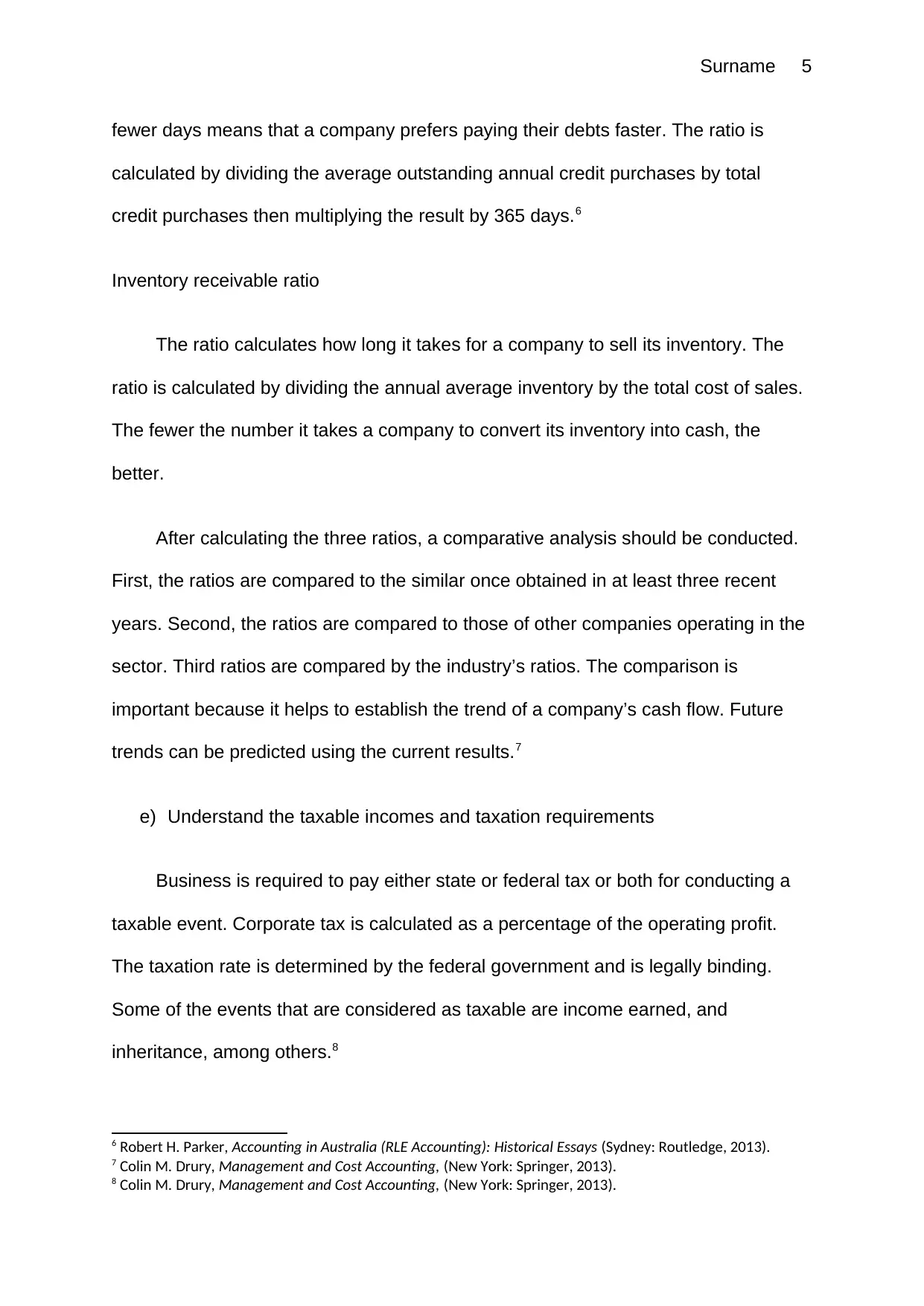
Surname 5
fewer days means that a company prefers paying their debts faster. The ratio is
calculated by dividing the average outstanding annual credit purchases by total
credit purchases then multiplying the result by 365 days.6
Inventory receivable ratio
The ratio calculates how long it takes for a company to sell its inventory. The
ratio is calculated by dividing the annual average inventory by the total cost of sales.
The fewer the number it takes a company to convert its inventory into cash, the
better.
After calculating the three ratios, a comparative analysis should be conducted.
First, the ratios are compared to the similar once obtained in at least three recent
years. Second, the ratios are compared to those of other companies operating in the
sector. Third ratios are compared by the industry’s ratios. The comparison is
important because it helps to establish the trend of a company’s cash flow. Future
trends can be predicted using the current results.7
e) Understand the taxable incomes and taxation requirements
Business is required to pay either state or federal tax or both for conducting a
taxable event. Corporate tax is calculated as a percentage of the operating profit.
The taxation rate is determined by the federal government and is legally binding.
Some of the events that are considered as taxable are income earned, and
inheritance, among others.8
6 Robert H. Parker, Accounting in Australia (RLE Accounting): Historical Essays (Sydney: Routledge, 2013).
7 Colin M. Drury, Management and Cost Accounting, (New York: Springer, 2013).
8 Colin M. Drury, Management and Cost Accounting, (New York: Springer, 2013).
fewer days means that a company prefers paying their debts faster. The ratio is
calculated by dividing the average outstanding annual credit purchases by total
credit purchases then multiplying the result by 365 days.6
Inventory receivable ratio
The ratio calculates how long it takes for a company to sell its inventory. The
ratio is calculated by dividing the annual average inventory by the total cost of sales.
The fewer the number it takes a company to convert its inventory into cash, the
better.
After calculating the three ratios, a comparative analysis should be conducted.
First, the ratios are compared to the similar once obtained in at least three recent
years. Second, the ratios are compared to those of other companies operating in the
sector. Third ratios are compared by the industry’s ratios. The comparison is
important because it helps to establish the trend of a company’s cash flow. Future
trends can be predicted using the current results.7
e) Understand the taxable incomes and taxation requirements
Business is required to pay either state or federal tax or both for conducting a
taxable event. Corporate tax is calculated as a percentage of the operating profit.
The taxation rate is determined by the federal government and is legally binding.
Some of the events that are considered as taxable are income earned, and
inheritance, among others.8
6 Robert H. Parker, Accounting in Australia (RLE Accounting): Historical Essays (Sydney: Routledge, 2013).
7 Colin M. Drury, Management and Cost Accounting, (New York: Springer, 2013).
8 Colin M. Drury, Management and Cost Accounting, (New York: Springer, 2013).
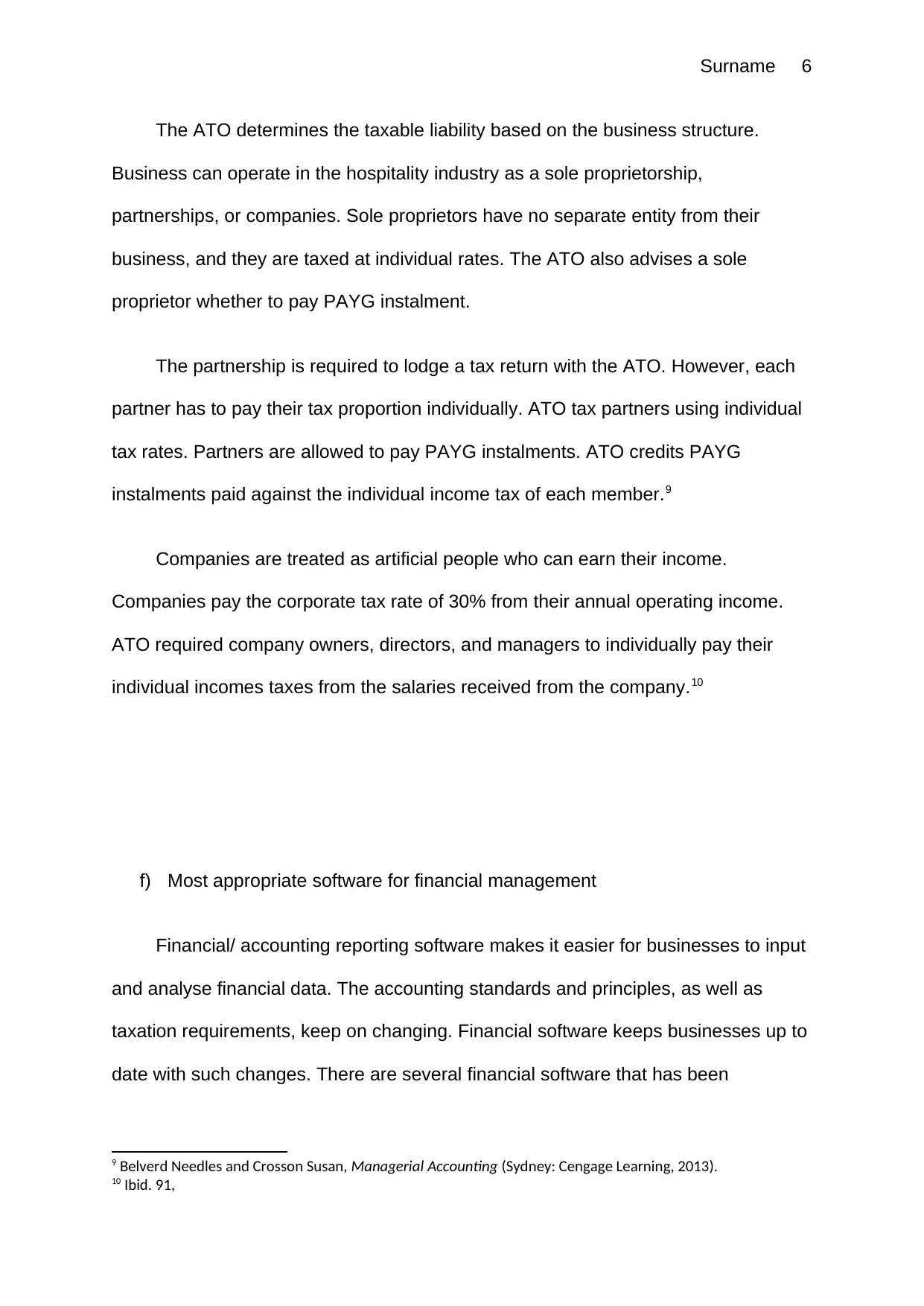
Surname 6
The ATO determines the taxable liability based on the business structure.
Business can operate in the hospitality industry as a sole proprietorship,
partnerships, or companies. Sole proprietors have no separate entity from their
business, and they are taxed at individual rates. The ATO also advises a sole
proprietor whether to pay PAYG instalment.
The partnership is required to lodge a tax return with the ATO. However, each
partner has to pay their tax proportion individually. ATO tax partners using individual
tax rates. Partners are allowed to pay PAYG instalments. ATO credits PAYG
instalments paid against the individual income tax of each member.9
Companies are treated as artificial people who can earn their income.
Companies pay the corporate tax rate of 30% from their annual operating income.
ATO required company owners, directors, and managers to individually pay their
individual incomes taxes from the salaries received from the company.10
f) Most appropriate software for financial management
Financial/ accounting reporting software makes it easier for businesses to input
and analyse financial data. The accounting standards and principles, as well as
taxation requirements, keep on changing. Financial software keeps businesses up to
date with such changes. There are several financial software that has been
9 Belverd Needles and Crosson Susan, Managerial Accounting (Sydney: Cengage Learning, 2013).
10 Ibid. 91,
The ATO determines the taxable liability based on the business structure.
Business can operate in the hospitality industry as a sole proprietorship,
partnerships, or companies. Sole proprietors have no separate entity from their
business, and they are taxed at individual rates. The ATO also advises a sole
proprietor whether to pay PAYG instalment.
The partnership is required to lodge a tax return with the ATO. However, each
partner has to pay their tax proportion individually. ATO tax partners using individual
tax rates. Partners are allowed to pay PAYG instalments. ATO credits PAYG
instalments paid against the individual income tax of each member.9
Companies are treated as artificial people who can earn their income.
Companies pay the corporate tax rate of 30% from their annual operating income.
ATO required company owners, directors, and managers to individually pay their
individual incomes taxes from the salaries received from the company.10
f) Most appropriate software for financial management
Financial/ accounting reporting software makes it easier for businesses to input
and analyse financial data. The accounting standards and principles, as well as
taxation requirements, keep on changing. Financial software keeps businesses up to
date with such changes. There are several financial software that has been
9 Belverd Needles and Crosson Susan, Managerial Accounting (Sydney: Cengage Learning, 2013).
10 Ibid. 91,
⊘ This is a preview!⊘
Do you want full access?
Subscribe today to unlock all pages.

Trusted by 1+ million students worldwide
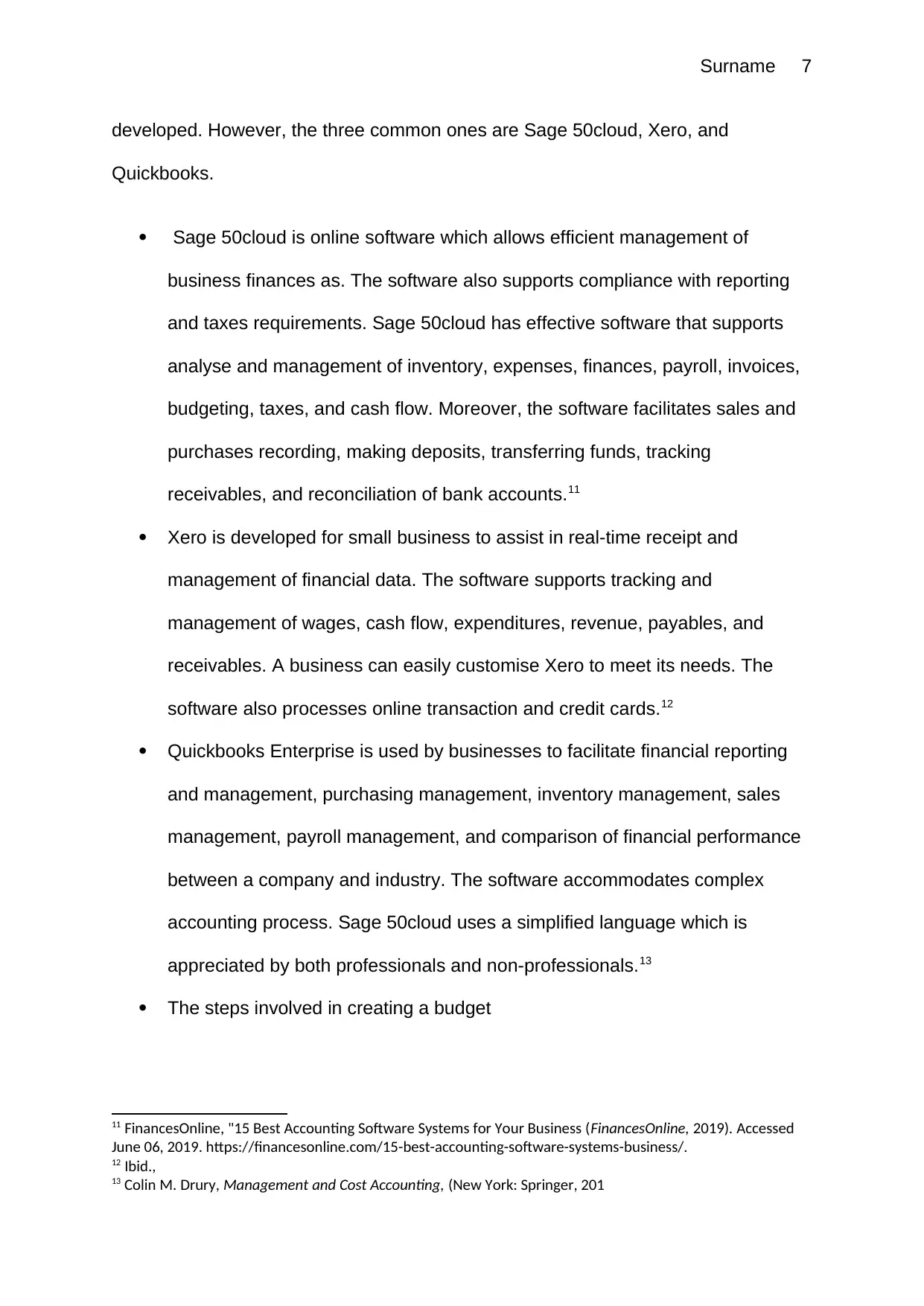
Surname 7
developed. However, the three common ones are Sage 50cloud, Xero, and
Quickbooks.
Sage 50cloud is online software which allows efficient management of
business finances as. The software also supports compliance with reporting
and taxes requirements. Sage 50cloud has effective software that supports
analyse and management of inventory, expenses, finances, payroll, invoices,
budgeting, taxes, and cash flow. Moreover, the software facilitates sales and
purchases recording, making deposits, transferring funds, tracking
receivables, and reconciliation of bank accounts.11
Xero is developed for small business to assist in real-time receipt and
management of financial data. The software supports tracking and
management of wages, cash flow, expenditures, revenue, payables, and
receivables. A business can easily customise Xero to meet its needs. The
software also processes online transaction and credit cards.12
Quickbooks Enterprise is used by businesses to facilitate financial reporting
and management, purchasing management, inventory management, sales
management, payroll management, and comparison of financial performance
between a company and industry. The software accommodates complex
accounting process. Sage 50cloud uses a simplified language which is
appreciated by both professionals and non-professionals.13
The steps involved in creating a budget
11 FinancesOnline, "15 Best Accounting Software Systems for Your Business (FinancesOnline, 2019). Accessed
June 06, 2019. https://financesonline.com/15-best-accounting-software-systems-business/.
12 Ibid.,
13 Colin M. Drury, Management and Cost Accounting, (New York: Springer, 201
developed. However, the three common ones are Sage 50cloud, Xero, and
Quickbooks.
Sage 50cloud is online software which allows efficient management of
business finances as. The software also supports compliance with reporting
and taxes requirements. Sage 50cloud has effective software that supports
analyse and management of inventory, expenses, finances, payroll, invoices,
budgeting, taxes, and cash flow. Moreover, the software facilitates sales and
purchases recording, making deposits, transferring funds, tracking
receivables, and reconciliation of bank accounts.11
Xero is developed for small business to assist in real-time receipt and
management of financial data. The software supports tracking and
management of wages, cash flow, expenditures, revenue, payables, and
receivables. A business can easily customise Xero to meet its needs. The
software also processes online transaction and credit cards.12
Quickbooks Enterprise is used by businesses to facilitate financial reporting
and management, purchasing management, inventory management, sales
management, payroll management, and comparison of financial performance
between a company and industry. The software accommodates complex
accounting process. Sage 50cloud uses a simplified language which is
appreciated by both professionals and non-professionals.13
The steps involved in creating a budget
11 FinancesOnline, "15 Best Accounting Software Systems for Your Business (FinancesOnline, 2019). Accessed
June 06, 2019. https://financesonline.com/15-best-accounting-software-systems-business/.
12 Ibid.,
13 Colin M. Drury, Management and Cost Accounting, (New York: Springer, 201
Paraphrase This Document
Need a fresh take? Get an instant paraphrase of this document with our AI Paraphraser
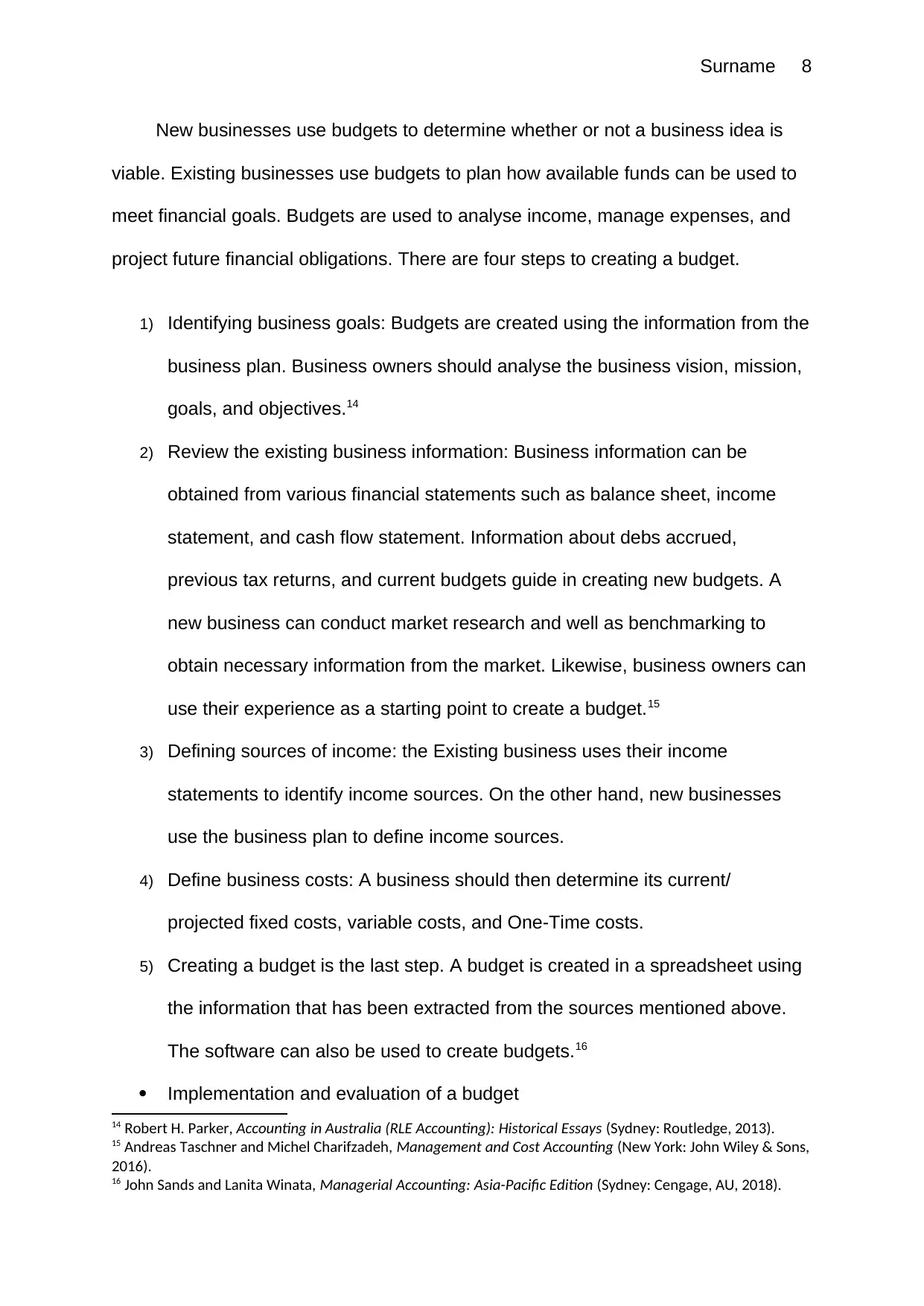
Surname 8
New businesses use budgets to determine whether or not a business idea is
viable. Existing businesses use budgets to plan how available funds can be used to
meet financial goals. Budgets are used to analyse income, manage expenses, and
project future financial obligations. There are four steps to creating a budget.
1) Identifying business goals: Budgets are created using the information from the
business plan. Business owners should analyse the business vision, mission,
goals, and objectives.14
2) Review the existing business information: Business information can be
obtained from various financial statements such as balance sheet, income
statement, and cash flow statement. Information about debs accrued,
previous tax returns, and current budgets guide in creating new budgets. A
new business can conduct market research and well as benchmarking to
obtain necessary information from the market. Likewise, business owners can
use their experience as a starting point to create a budget.15
3) Defining sources of income: the Existing business uses their income
statements to identify income sources. On the other hand, new businesses
use the business plan to define income sources.
4) Define business costs: A business should then determine its current/
projected fixed costs, variable costs, and One-Time costs.
5) Creating a budget is the last step. A budget is created in a spreadsheet using
the information that has been extracted from the sources mentioned above.
The software can also be used to create budgets.16
Implementation and evaluation of a budget
14 Robert H. Parker, Accounting in Australia (RLE Accounting): Historical Essays (Sydney: Routledge, 2013).
15 Andreas Taschner and Michel Charifzadeh, Management and Cost Accounting (New York: John Wiley & Sons,
2016).
16 John Sands and Lanita Winata, Managerial Accounting: Asia-Pacific Edition (Sydney: Cengage, AU, 2018).
New businesses use budgets to determine whether or not a business idea is
viable. Existing businesses use budgets to plan how available funds can be used to
meet financial goals. Budgets are used to analyse income, manage expenses, and
project future financial obligations. There are four steps to creating a budget.
1) Identifying business goals: Budgets are created using the information from the
business plan. Business owners should analyse the business vision, mission,
goals, and objectives.14
2) Review the existing business information: Business information can be
obtained from various financial statements such as balance sheet, income
statement, and cash flow statement. Information about debs accrued,
previous tax returns, and current budgets guide in creating new budgets. A
new business can conduct market research and well as benchmarking to
obtain necessary information from the market. Likewise, business owners can
use their experience as a starting point to create a budget.15
3) Defining sources of income: the Existing business uses their income
statements to identify income sources. On the other hand, new businesses
use the business plan to define income sources.
4) Define business costs: A business should then determine its current/
projected fixed costs, variable costs, and One-Time costs.
5) Creating a budget is the last step. A budget is created in a spreadsheet using
the information that has been extracted from the sources mentioned above.
The software can also be used to create budgets.16
Implementation and evaluation of a budget
14 Robert H. Parker, Accounting in Australia (RLE Accounting): Historical Essays (Sydney: Routledge, 2013).
15 Andreas Taschner and Michel Charifzadeh, Management and Cost Accounting (New York: John Wiley & Sons,
2016).
16 John Sands and Lanita Winata, Managerial Accounting: Asia-Pacific Edition (Sydney: Cengage, AU, 2018).
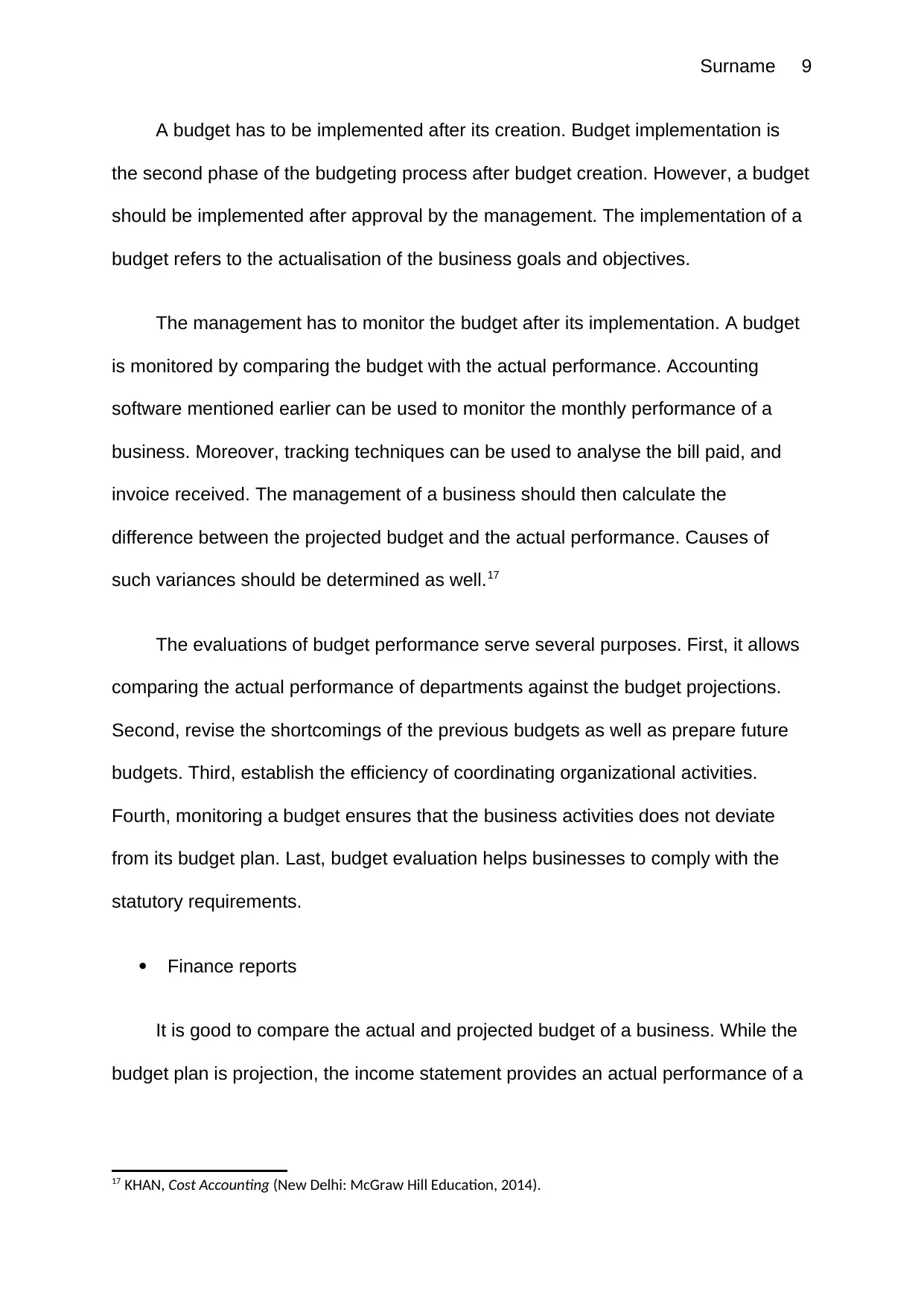
Surname 9
A budget has to be implemented after its creation. Budget implementation is
the second phase of the budgeting process after budget creation. However, a budget
should be implemented after approval by the management. The implementation of a
budget refers to the actualisation of the business goals and objectives.
The management has to monitor the budget after its implementation. A budget
is monitored by comparing the budget with the actual performance. Accounting
software mentioned earlier can be used to monitor the monthly performance of a
business. Moreover, tracking techniques can be used to analyse the bill paid, and
invoice received. The management of a business should then calculate the
difference between the projected budget and the actual performance. Causes of
such variances should be determined as well.17
The evaluations of budget performance serve several purposes. First, it allows
comparing the actual performance of departments against the budget projections.
Second, revise the shortcomings of the previous budgets as well as prepare future
budgets. Third, establish the efficiency of coordinating organizational activities.
Fourth, monitoring a budget ensures that the business activities does not deviate
from its budget plan. Last, budget evaluation helps businesses to comply with the
statutory requirements.
Finance reports
It is good to compare the actual and projected budget of a business. While the
budget plan is projection, the income statement provides an actual performance of a
17 KHAN, Cost Accounting (New Delhi: McGraw Hill Education, 2014).
A budget has to be implemented after its creation. Budget implementation is
the second phase of the budgeting process after budget creation. However, a budget
should be implemented after approval by the management. The implementation of a
budget refers to the actualisation of the business goals and objectives.
The management has to monitor the budget after its implementation. A budget
is monitored by comparing the budget with the actual performance. Accounting
software mentioned earlier can be used to monitor the monthly performance of a
business. Moreover, tracking techniques can be used to analyse the bill paid, and
invoice received. The management of a business should then calculate the
difference between the projected budget and the actual performance. Causes of
such variances should be determined as well.17
The evaluations of budget performance serve several purposes. First, it allows
comparing the actual performance of departments against the budget projections.
Second, revise the shortcomings of the previous budgets as well as prepare future
budgets. Third, establish the efficiency of coordinating organizational activities.
Fourth, monitoring a budget ensures that the business activities does not deviate
from its budget plan. Last, budget evaluation helps businesses to comply with the
statutory requirements.
Finance reports
It is good to compare the actual and projected budget of a business. While the
budget plan is projection, the income statement provides an actual performance of a
17 KHAN, Cost Accounting (New Delhi: McGraw Hill Education, 2014).
⊘ This is a preview!⊘
Do you want full access?
Subscribe today to unlock all pages.

Trusted by 1+ million students worldwide
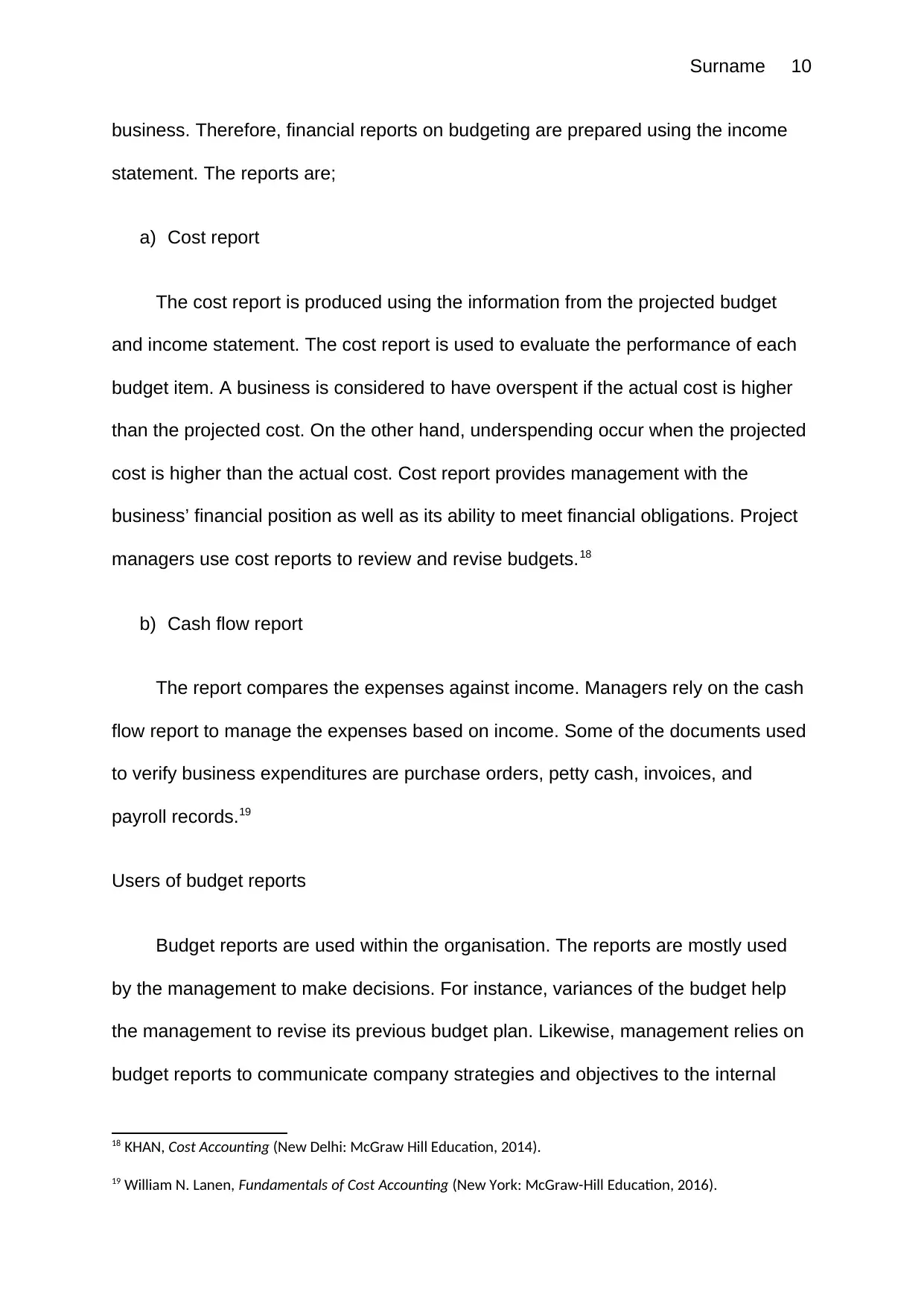
Surname 10
business. Therefore, financial reports on budgeting are prepared using the income
statement. The reports are;
a) Cost report
The cost report is produced using the information from the projected budget
and income statement. The cost report is used to evaluate the performance of each
budget item. A business is considered to have overspent if the actual cost is higher
than the projected cost. On the other hand, underspending occur when the projected
cost is higher than the actual cost. Cost report provides management with the
business’ financial position as well as its ability to meet financial obligations. Project
managers use cost reports to review and revise budgets.18
b) Cash flow report
The report compares the expenses against income. Managers rely on the cash
flow report to manage the expenses based on income. Some of the documents used
to verify business expenditures are purchase orders, petty cash, invoices, and
payroll records.19
Users of budget reports
Budget reports are used within the organisation. The reports are mostly used
by the management to make decisions. For instance, variances of the budget help
the management to revise its previous budget plan. Likewise, management relies on
budget reports to communicate company strategies and objectives to the internal
18 KHAN, Cost Accounting (New Delhi: McGraw Hill Education, 2014).
19 William N. Lanen, Fundamentals of Cost Accounting (New York: McGraw-Hill Education, 2016).
business. Therefore, financial reports on budgeting are prepared using the income
statement. The reports are;
a) Cost report
The cost report is produced using the information from the projected budget
and income statement. The cost report is used to evaluate the performance of each
budget item. A business is considered to have overspent if the actual cost is higher
than the projected cost. On the other hand, underspending occur when the projected
cost is higher than the actual cost. Cost report provides management with the
business’ financial position as well as its ability to meet financial obligations. Project
managers use cost reports to review and revise budgets.18
b) Cash flow report
The report compares the expenses against income. Managers rely on the cash
flow report to manage the expenses based on income. Some of the documents used
to verify business expenditures are purchase orders, petty cash, invoices, and
payroll records.19
Users of budget reports
Budget reports are used within the organisation. The reports are mostly used
by the management to make decisions. For instance, variances of the budget help
the management to revise its previous budget plan. Likewise, management relies on
budget reports to communicate company strategies and objectives to the internal
18 KHAN, Cost Accounting (New Delhi: McGraw Hill Education, 2014).
19 William N. Lanen, Fundamentals of Cost Accounting (New York: McGraw-Hill Education, 2016).
Paraphrase This Document
Need a fresh take? Get an instant paraphrase of this document with our AI Paraphraser
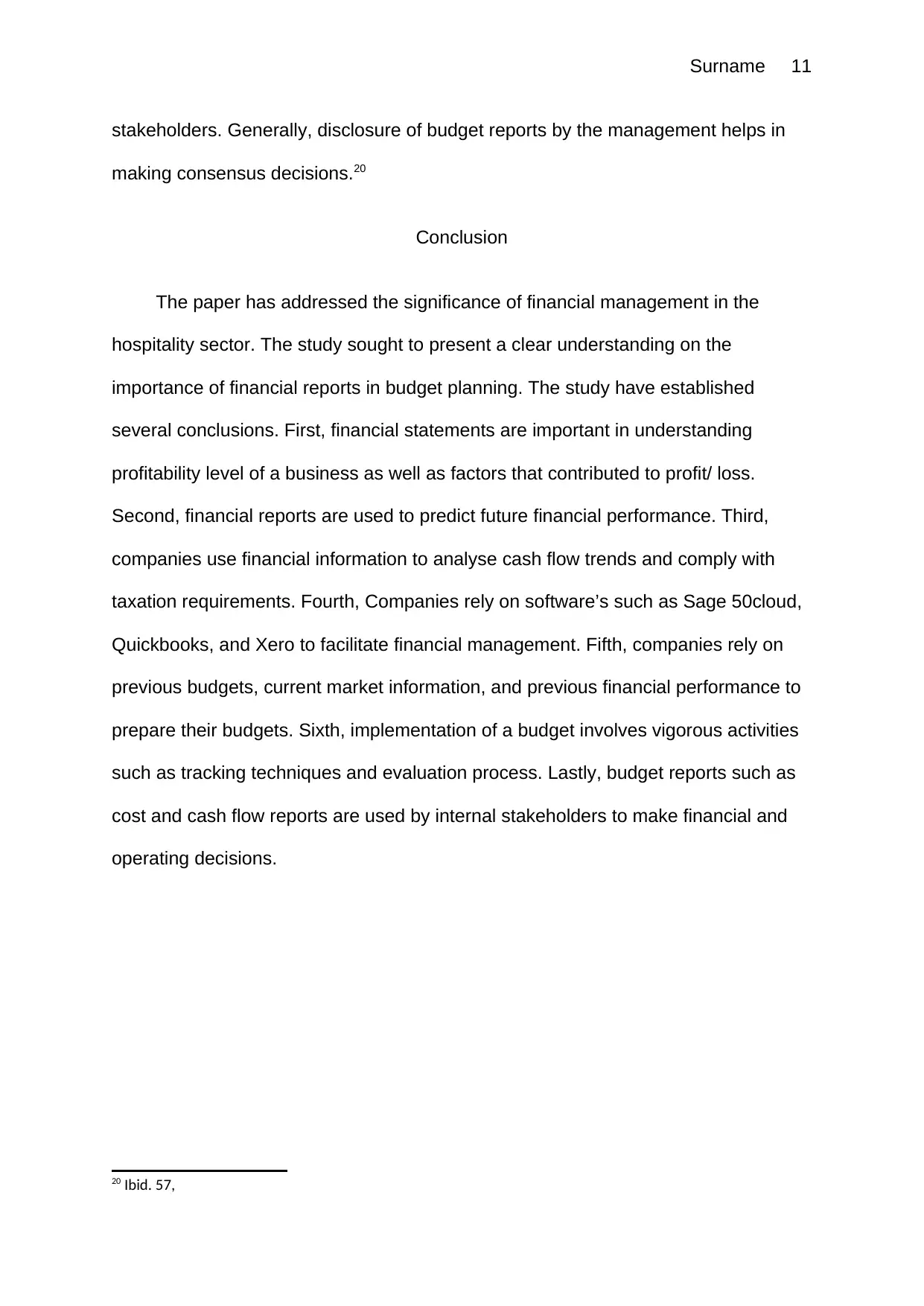
Surname 11
stakeholders. Generally, disclosure of budget reports by the management helps in
making consensus decisions.20
Conclusion
The paper has addressed the significance of financial management in the
hospitality sector. The study sought to present a clear understanding on the
importance of financial reports in budget planning. The study have established
several conclusions. First, financial statements are important in understanding
profitability level of a business as well as factors that contributed to profit/ loss.
Second, financial reports are used to predict future financial performance. Third,
companies use financial information to analyse cash flow trends and comply with
taxation requirements. Fourth, Companies rely on software’s such as Sage 50cloud,
Quickbooks, and Xero to facilitate financial management. Fifth, companies rely on
previous budgets, current market information, and previous financial performance to
prepare their budgets. Sixth, implementation of a budget involves vigorous activities
such as tracking techniques and evaluation process. Lastly, budget reports such as
cost and cash flow reports are used by internal stakeholders to make financial and
operating decisions.
20 Ibid. 57,
stakeholders. Generally, disclosure of budget reports by the management helps in
making consensus decisions.20
Conclusion
The paper has addressed the significance of financial management in the
hospitality sector. The study sought to present a clear understanding on the
importance of financial reports in budget planning. The study have established
several conclusions. First, financial statements are important in understanding
profitability level of a business as well as factors that contributed to profit/ loss.
Second, financial reports are used to predict future financial performance. Third,
companies use financial information to analyse cash flow trends and comply with
taxation requirements. Fourth, Companies rely on software’s such as Sage 50cloud,
Quickbooks, and Xero to facilitate financial management. Fifth, companies rely on
previous budgets, current market information, and previous financial performance to
prepare their budgets. Sixth, implementation of a budget involves vigorous activities
such as tracking techniques and evaluation process. Lastly, budget reports such as
cost and cash flow reports are used by internal stakeholders to make financial and
operating decisions.
20 Ibid. 57,
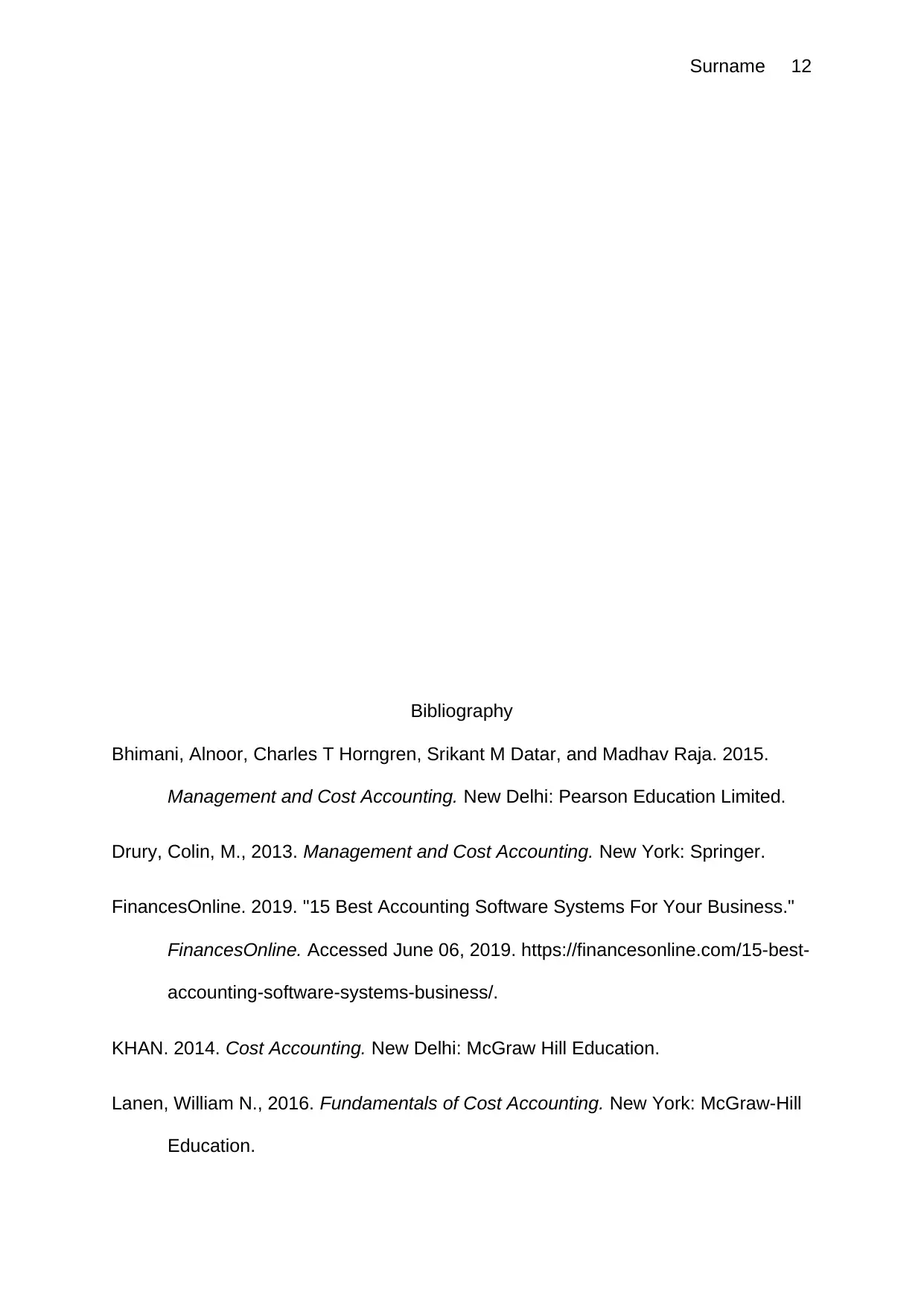
Surname 12
Bibliography
Bhimani, Alnoor, Charles T Horngren, Srikant M Datar, and Madhav Raja. 2015.
Management and Cost Accounting. New Delhi: Pearson Education Limited.
Drury, Colin, M., 2013. Management and Cost Accounting. New York: Springer.
FinancesOnline. 2019. "15 Best Accounting Software Systems For Your Business."
FinancesOnline. Accessed June 06, 2019. https://financesonline.com/15-best-
accounting-software-systems-business/.
KHAN. 2014. Cost Accounting. New Delhi: McGraw Hill Education.
Lanen, William N., 2016. Fundamentals of Cost Accounting. New York: McGraw-Hill
Education.
Bibliography
Bhimani, Alnoor, Charles T Horngren, Srikant M Datar, and Madhav Raja. 2015.
Management and Cost Accounting. New Delhi: Pearson Education Limited.
Drury, Colin, M., 2013. Management and Cost Accounting. New York: Springer.
FinancesOnline. 2019. "15 Best Accounting Software Systems For Your Business."
FinancesOnline. Accessed June 06, 2019. https://financesonline.com/15-best-
accounting-software-systems-business/.
KHAN. 2014. Cost Accounting. New Delhi: McGraw Hill Education.
Lanen, William N., 2016. Fundamentals of Cost Accounting. New York: McGraw-Hill
Education.
⊘ This is a preview!⊘
Do you want full access?
Subscribe today to unlock all pages.

Trusted by 1+ million students worldwide
1 out of 13
Related Documents
Your All-in-One AI-Powered Toolkit for Academic Success.
+13062052269
info@desklib.com
Available 24*7 on WhatsApp / Email
![[object Object]](/_next/static/media/star-bottom.7253800d.svg)
Unlock your academic potential
Copyright © 2020–2025 A2Z Services. All Rights Reserved. Developed and managed by ZUCOL.



